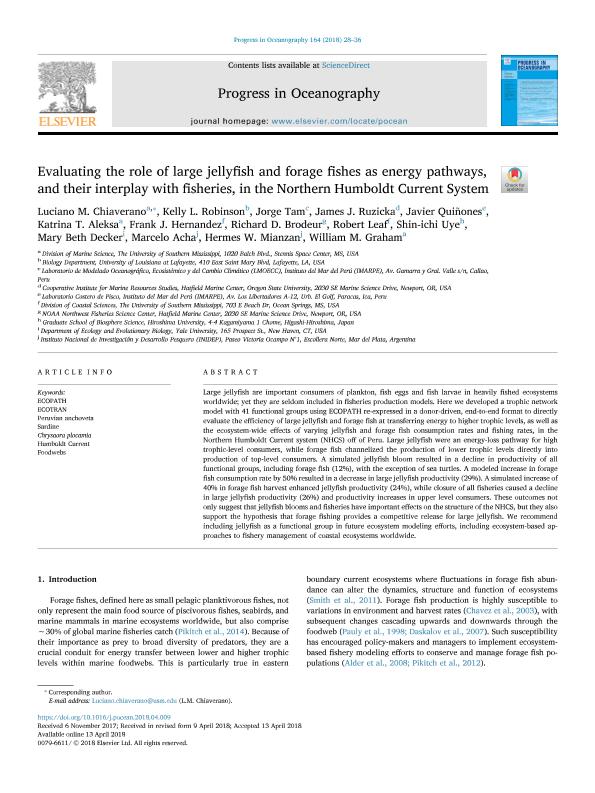Artículo
Evaluating the role of large jellyfish and forage fishes as energy pathways, and their interplay with fisheries, in the Northern Humboldt Current System
Chiaverano, Luciano; Robinson, Kelly L.; Tam, Jorge; Ruzicka, James J.; Quiñones, Javier; Aleksa, Katrina T.; Hernandez, Frank J.; Brodeur, Richard D.; Leaf, Robert; Uye, Shin-ichi; Decker, Mary Beth; Acha, Eduardo Marcelo ; Mianzan, Hermes Walter
; Mianzan, Hermes Walter ; Graham, William M.
; Graham, William M.
 ; Mianzan, Hermes Walter
; Mianzan, Hermes Walter ; Graham, William M.
; Graham, William M.
Fecha de publicación:
05/2018
Editorial:
Pergamon-Elsevier Science Ltd
Revista:
Progress In Oceanography
ISSN:
0079-6611
Idioma:
Inglés
Tipo de recurso:
Artículo publicado
Clasificación temática:
Resumen
Large jellyfish are important consumers of plankton, fish eggs and fish larvae in heavily fished ecosystems worldwide; yet they are seldom included in fisheries production models. Here we developed a trophic network model with 41 functional groups using ECOPATH re-expressed in a donor-driven, end-to-end format to directly evaluate the efficiency of large jellyfish and forage fish at transferring energy to higher trophic levels, as well as the ecosystem-wide effects of varying jellyfish and forage fish consumption rates and fishing rates, in the Northern Humboldt Current system (NHCS) off of Peru. Large jellyfish were an energy-loss pathway for high trophic-level consumers, while forage fish channelized the production of lower trophic levels directly into production of top-level consumers. A simulated jellyfish bloom resulted in a decline in productivity of all functional groups, including forage fish (12%), with the exception of sea turtles. A modeled increase in forage fish consumption rate by 50% resulted in a decrease in large jellyfish productivity (29%). A simulated increase of 40% in forage fish harvest enhanced jellyfish productivity (24%), while closure of all fisheries caused a decline in large jellyfish productivity (26%) and productivity increases in upper level consumers. These outcomes not only suggest that jellyfish blooms and fisheries have important effects on the structure of the NHCS, but they also support the hypothesis that forage fishing provides a competitive release for large jellyfish. We recommend including jellyfish as a functional group in future ecosystem modeling efforts, including ecosystem-based approaches to fishery management of coastal ecosystems worldwide.
Archivos asociados
Licencia
Identificadores
Colecciones
Articulos(CCT - MAR DEL PLATA)
Articulos de CTRO.CIENTIFICO TECNOL.CONICET - MAR DEL PLATA
Articulos de CTRO.CIENTIFICO TECNOL.CONICET - MAR DEL PLATA
Citación
Chiaverano, Luciano; Robinson, Kelly L.; Tam, Jorge; Ruzicka, James J.; Quiñones, Javier; et al.; Evaluating the role of large jellyfish and forage fishes as energy pathways, and their interplay with fisheries, in the Northern Humboldt Current System; Pergamon-Elsevier Science Ltd; Progress In Oceanography; 164; 5-2018; 28-36
Compartir
Altmétricas



